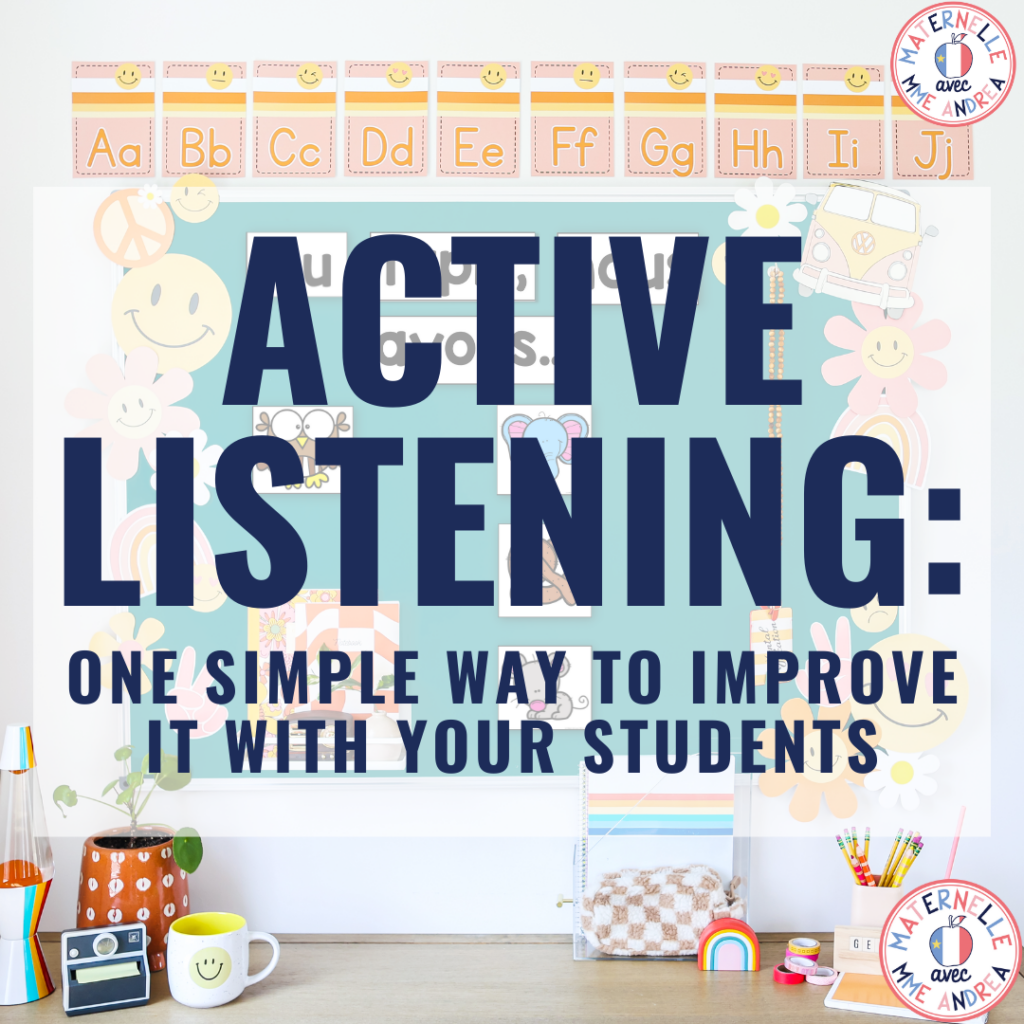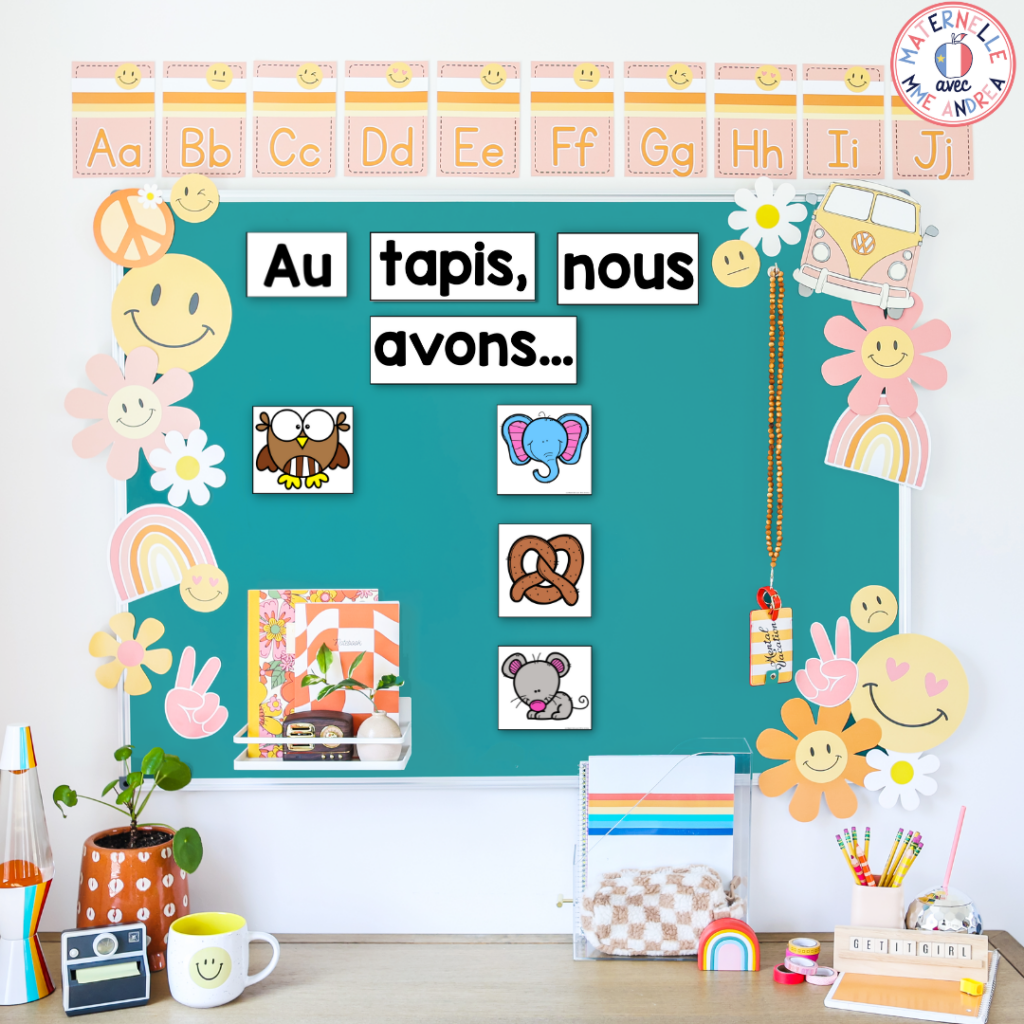One challenge you’ll definitely face every single September (especially if you are a maternelle teacher)?, Getting your French primary students to show active listening in the classroom!
This can be a tough job for even the calmest 5 year olds, but if your students don’t understand much French yet, getting them to listen is not going to be easy. To them, you likely sound like the teacher from Charlie Brown!
Fortunately, I’ve been around the block a few times. As always, I am here to share my best tried and true tips with you.
Over the years and via much trial-and-error, I have found what I consider the best way to get even my youngest students learning active listening skills. This idea can work as early as the first week of school.
My solution has three parts. In this blog post, I will explain all three of them to you. I’ll also give you everything you’ll need to get started in your own classroom!

Part 1: Co-create a poster
For me, the trick to getting my students to buy into an expectation or a new routine is to start off making sure they understand it and can relate to it.
This means that I do not come up with classroom expectations on my own and then read them off of a poster!
But, I do create a framework that I know my students will relate to. This framework is heavy on the visuals. Then, we fill out the rest of the framework together, ensuring that my students understand what I mean.
When my students arrive on the carpet on the very first day of school, they will see a skeleton of a poster that we will finish creating together. The poster goes over our expectations at the carpet.
All that is on this poster to start is the title and four picture cards. The rest, we will fill out together.
The poster that we co-create is very simple. It shows four target behaviours and there is a picture to anchor each behaviour to. This way, my students can just glance at the poster and remember what I want them to do.

It’s worth mentioning as well that these are our expectations just for the carpet. Other places in the classroom might have different expectations. So, this poster stays on display at the carpet for as long as I need to reference it and my students need to be able to see it.
The four pictures that students will see on the poster are as follows:
- An owl – the owl reminds students to look at the person who is speaking.
- An elephant – an elephant has big ears. This picture reminds students to listen with their ears when someone is speaking.
- A pretzel – the pretzel reminds students of how they should be sitting on the carpet. I also like to include a mountain picture, because sitting like a pretzel is not comfortable for all students. By providing a couple options, students are more likely to choose one that works for them AND works for me. The main thing is we want to make sure students aren’t sitting in someone else’s space and are keeping their bodies to themselves.
- A mouse – The mouse reminds students to sit quietly and wait their turn to talk. Mice are known to be quiet, making this a great visual reminder not to speak while someone else is speaking.
- Later on in the year, I do like to add another picture that is just a picture of lips. The lips remind my students to only speak in French at the carpet. They’re often not quite ready for that yet at the beginning of the year, though.
I have each picture already stuck to the poster along with the title before we begin. Then, I ask my students to tell me what each picture reminds them of and how they think it could help them remember to listen at the carpet.
I guide them to find the responses that I’m looking for, and then I write them in.

Part 2: Refer to the active listening poster often
You’ll want to make sure this poster is on display somewhere near your carpet, where all students can see it.
When you first introduce these active listening expectations, have students review the poster and all of the active listening in the classroom components before you begin a lesson.
Later, when your students are very familiar with this, you only need to refer to it on an as-needs basis. Everyone forgets sometimes. ;)
Usually I keep this on my wall all year,.
To “prove” to students that they are able to do all of the active listening components at the same time, I will often have students practice doing one at a time, then two at a time, then three… until they are doing all of the things on the poster at once. This might take a few practices for everyone to master, but it’s worth it!
Part 3: Wear an Active Listening in the Classroom Reminder Necklace
The final piece of my active listening in the classroom visuals are a necklace that I, the teacher, wear.
The necklace contains a smaller picture of each of the poster pieces. This way, I have the visuals right around my neck, at my fingertips, whenever I need.
Here’s a peek at the necklace pieces pointed out. I just hole punched the top and put them on a cord.

When I am ready to teach, if a student (or some students) is not showing active listening, I can just flip to the picture that they are forgetting and point to it.
That way, I don’t have to call out a student or nag them. I just point to what they are forgetting without saying a word and they know what I want them to do.
If I am sitting down already and my poster is out of reach, I can also review each of the active listening expectations just by flipping through the necklace. I really love having our expectations on my body throughout the day.
As a teacher and as a human, I am not a nagger. I can’t stand nagging or being nagged! This necklace and the poster really helps me help my students find success with active listening… without me nagging them over and over.
Bonus tip: Focus on who is doing the RIGHT thing
My final tip for active listening in the classroom has nothing to do with the posters or the necklace, but just a little tip that you can do anytime.
When someone is not doing the right thing, it’s often our instinct to tell them what to do. But, this can be upsetting or embarrassing for our students and might even lead to the opposite behaviour of what we want.
What I find helpful is to point out a student who is doing the right thing. So, instead of saying “Bob, I’m waiting for you to sit like a pretzel!”, I might say, “Wow everyone! Look at Sarah and how she is doing all of the right things all at the same time! I would love to see everyone else doing that too!”
Young students love hearing praise like that, so you will probably see all of your students snap to it to try to be just like Sarah and hear praise, too.
“Thumbs up” to everyone doing the right thing can be very encouraging if you don’t have time to congratulate everyone by name. ;)
Want to try my tips this year?
If you want to try out my référentiel and necklace at the carpet with your French students this year, you can download all of my anchor chart and necklace pieces for FREE!
Just click here, enter your first name & email, and I’ll send them your way.
Having pictures to print out instead of trying to draw them by hand can really make life easier, haha!
And, hopefully these carpet expectations being anchored to an animal/object will help you sound less like a teacher from Charlie Brown and more like the awesome teacher you are while your students are still learning the target language ;)
If you’re looking for another activity to do with your students at the carpet, check our my morning messages! They target the alphabet, and come in physical or digital copies :)

